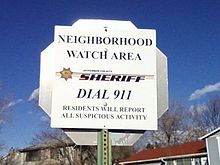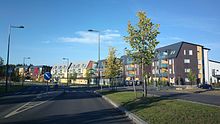Neighbourhood
| Ekistics |
|---|
 |
|
|

A neighbourhood (Commonwealth English) or neighborhood (American English) is a geographically localized community within a larger city, town, suburb or rural area, sometimes consisting of a single street and the buildings lining it. Neighbourhoods are often social communities with considerable face-to-face interaction among members. Researchers have not agreed on an exact definition, but the following may serve as a starting point: "Neighbourhood is generally defined spatially as a specific geographic area and functionally as a set of social networks. Neighbourhoods, then, are the spatial units in which face-to-face social interactions occur—the personal settings and situations where residents seek to realise common values, socialise youth, and maintain effective social control."[clarification needed][1]
Preindustrial cities[edit]
In the words of the urban scholar Lewis Mumford, "Neighborhoods, in some annoying, inchoate fashion exist wherever human beings congregate, in permanent family dwellings; and many of the functions of the city tend to be distributed naturally—that is, without any theoretical preoccupation or political direction—into neighborhoods."[2] Most of the earliest cities around the world as excavated by archaeologists have evidence for the presence of social neighbourhoods.[3] Historical documents shed light on neighbourhood life in numerous historical preindustrial or nonwestern cities.[4]
Neighbourhoods are typically generated by social interaction among people living near one another. In this sense they are local social units larger than households not directly under the control of city or state officials. In some preindustrial urban traditions, basic municipal functions such as protection, social regulation of births and marriages, cleaning and upkeep are handled informally by neighbourhoods and not by urban governments; this pattern is well documented for historical Islamic cities.[5]
In addition to social neighbourhoods, most ancient and historical cities also had administrative districts used by officials for taxation, record-keeping, and social control.[6] Administrative districts are typically larger than neighbourhoods and their boundaries may cut across neighbourhood divisions. In some cases, however, administrative districts coincided with neighbourhoods, leading to a high level of regulation of social life by officials. For example, in the T'ang period Chinese capital city Chang'an, neighbourhoods were districts and there were state officials who carefully controlled life and activity at the neighbourhood level.[7]
Neighbourhoods in preindustrial cities often had some degree of social specialisation or differentiation. Ethnic neighbourhoods were important in many past cities and remain common in cities today. Economic specialists, including craft producers, merchants, and others, could be concentrated in neighbourhoods, and in societies with religious pluralism neighbourhoods were often specialised by religion. One factor contributing to neighbourhood distinctiveness and social cohesion in past cities was the role of rural to urban migration. This was a continual process in preindustrial cities, and migrants tended to move in with relatives and acquaintances from their rural past.[8]
Sociology[edit]
Neighbourhood sociology is a subfield of urban sociology which studies local communities[9][10] Neighbourhoods are also used in research studies from postal codes and health disparities, to correlations with school drop out rates or use of drugs.[11] Some attention has also been devoted to viewing the neighbourhood as a small-scale democracy, regulated primarily by ideas of reciprocity among neighbours.[12]
Improvement[edit]

Neighbourhoods have been the site of service delivery or "service interventions" in part as efforts to provide local, quality services, and to increase the degree of local control and ownership.[13] Alfred Kahn, as early as the mid-1970s, described the "experience, theory and fads" of neighbourhood service delivery over the prior decade, including discussion of income transfers and poverty.[14] Neighbourhoods, as a core aspect of community, also are the site of services for youth, including children with disabilities[15] and coordinated approaches to low-income populations.[16] While the term neighbourhood organisation[17] is not as common in 2015, these organisations often are non-profit, sometimes grassroots or even core funded community development centres or branches.
Community and economic development activists have pressured for reinvestment in local communities and neighbourhoods. In the early 2000s, Community Development Corporations, Rehabilitation Networks, Neighbourhood Development Corporations, and Economic Development organisations would work together to address the housing stock and the infrastructures of communities and neighbourhoods (e.g., community centres).[18] Community and Economic Development may be understood in different ways, and may involve "faith-based" groups and congregations in cities.[19]
As a unit in urban design[edit]
In the 1900s, Clarence Perry described the idea of a neighbourhood unit as a self-contained residential area within a city. The concept is still influential in New Urbanism. Practitioners seek to revive traditional sociability in planned suburban housing based on a set of principles. At the same time, the neighbourhood is a site of interventions to create Age-Friendly Cities and Communities (AFCC) as many older adults tend to have narrower life space. Urban design studies thus use neighbourhood as a unit of analysis.[20]
Neighbourhoods around the world[edit]
Asia[edit]

China[edit]
In mainland China, the term is generally used for the urban administrative division found immediately below the district level, although an intermediate, subdistrict level exists in some cities. They are also called streets (administrative terminology may vary from city to city). Neighbourhoods encompass 2,000 to 10,000 families. Within neighbourhoods, families are grouped into smaller residential units or quarters of 100 to 600 families and supervised by a residents' committee; these are subdivided into residents' small groups of fifteen to forty families. In most urban areas of China, neighbourhood, community, residential community, residential unit, residential quarter have the same meaning: 社区 or 小区 or 居民区 or 居住区, and is the direct sublevel of a subdistrict (街道办事处), which is the direct sublevel of a district (区), which is the direct sublevel of a city (市). (See Administrative divisions of the People's Republic of China)
Europe[edit]


United Kingdom[edit]
The term has no general official or statistical purpose in the United Kingdom, but is often used by local boroughs for self-chosen sub-divisions of their area for the delivery of various services and functions, as for example in Kingston-upon-Thames[21] or is used as an informal term to refer to a small area within a town or city. The label is commonly used to refer to organisations which relate to such a very local structure, such as neighbourhood policing[22] or Neighbourhood watch schemes. In addition, government statistics for local areas are often referred to as neighbourhood statistics, although the data themselves are broken down usually into districts and wards for local purposes. In many parts of the UK wards are roughly equivalent to neighbourhoods or a combination of them.
North America[edit]
("Neighborhood" is spelled with an -or rather than -our in the US and reflected as such here)
In the United States and Canada, neighborhoods are often given official or semi-official status through neighborhood associations, neighborhood watches or block watches. These may regulate such matters as lawn care and fence height, and they may provide such services as block parties, neighborhood parks and community security. In some other places the equivalent organization is the parish, though a parish may have several neighborhoods within it depending on the area.
In localities where neighborhoods do not have an official status, questions can arise as to where one neighborhood begins and another ends. Many cities use districts and wards as official divisions of the city, rather than traditional neighborhood boundaries. ZIP Code boundaries and post office names also sometimes reflect neighborhood identities.
See also[edit]
- Barangay (Philippines)
- Barrio (Spanish)
- Bairro (Portuguese)
- Block Parent Program (Canada)
- Borough
- Census-designated place
- Committees for the Defense of the Revolution (Cuba)
- Community
- Comparison of Home Owners' and Civic Associations
- Electoral precinct
- Frazione (Italian)
- Homeowners' association
- Kiez (German)
- Komshi (Balkan states during the Ottoman Empire)
- Mahalle
- Mister Rogers' Neighborhood
- Neighbourhood Watch
- New urbanism
- Pedestrian village
- Quarter
- Residential community
- Suburbs
- Unincorporated community
- Viertel (disambiguation) (German)
References[edit]
- Citations
- ^ Schuck, Amie and Dennis Rosenbuam 2006 "Promoting Safe and Healthy Neighborhoods: What Research Tells Us about Intervention." The Aspen Institute.
- ^ Mumford, Lewis (1954). The Neighborhood and the Neighborhood Unit. Town Planning Review 24:256–270, p. 258.
- ^ For example, Spence, Michael W. (1992) Tlailotlacan, a Zapotec Enclave in Teotihuacan. In Art, Ideology, and the City of Teotihuacan, edited by Janet C. Berlo, pp. 59–88. Dumbarton Oaks, Washington, D.C. Stone, Elizabeth C. (1987) Nippur Neighbourhoods. Studies in Ancient Oriental Civilization vol. 44. Oriental Institute, University of Chicago, Chicago
- ^ Some examples: Heng, Chye Kiang (1999) Cities of Aristocrats and Bureaucrats: The Development of Medieval Chinese Cityscapes. University of Hawai'i Press, Honolulu. Marcus, Abraham (1989) The Middle East on the Eve of Modernity: Aleppo in the Eighteenth Century. Columbia University Press, New York. Smail, Daniel Lord (2000). Imaginary Cartographies: Possession and Identity in Late Medieval Marseille. Cornell University Press, Ithaca.
- ^ Abu-Lughod, Janet L. (1987) The Islamic City: Historic Myth, Islamic Essence, and Contemporary Relevance. International Journal of Middle East Studies 19:155–176.
- ^ Dickinson, Robert E. (1961) The West European City: A Geographical Interpretation. Routledge & Paul, London, p. 529. See also: Jacobs, Jane (1961) The Death and Life of Great American Cities. Random House, New York, p. 117.
- ^ Xiong, Victor Cunrui (2000) Sui-Tang Chang'an: A Study in the Urban History of Medieval China. Center for Chinese Studies, University of Michigan, Ann Arbor.
- ^ Kemper, Robert V. (1977) Migration and Adaptation: Tzintzuntzan Peasants in Mexico City. Sage Publications, Beverly Hills. Greenshields, T. H. (1980) "Quarters" and Ethnicity. In The Changing Middle Eastern City, edited by G. H. Blake and R. I. Lawless, pp. 120–140. Croom Helm, London.
- ^ Wellman, B. & Leighton, B. (1979, March). Networks, neighbourhoods and communities: Approaches to the study of the community question. Urban Affairs Quarterly, 14(3): 363-390.
- ^ Warren, D. (1977). The functional diversity of urban neighbourhoods. Urban Affairs Quarterly, 13(2): 151-180.
- ^ Overman, H.G. (2002). Neighborhood effects in large and small neighborhoods. Urban Studies, 39(1): 117-130.
- ^ Rosenblum, Nancy L. (2020-12-01). "The Democracy of Everyday Life in Disaster: Holding Our Lives in Their Hands". Democratic Theory. 7 (2): 69–74. doi:10.3167/dt.2020.070209. ISSN 2332-8894.
- ^ King, B. & Meyers, J. (1996). The Annie E. Casey Foundation's mental health initiative for urban children. (pp. 249-261). In: B. Stroul & R.M. Friedman, Children's Mental Health. Baltimore, MD: Paul H. Brookes.
- ^ Kahn, A.J. (1976). Service delivery at the neighborhood level: Experience, theory and fads. Social Service Review, 50(1): 23-56.
- ^ Kutash, K., Duchnowski, A.J., Meyers, J. & King, B. (1997). Ch. 3: Community and neighborhood-based services for youth. In: S. Henggeler & A. B. Santor, Innovative Approaches to Difficult to Treat Populations. Washington, DC: American Psychiatric Press.
- ^ Riessman, F. (1967). A neighborhood-based mental health approach. (pp.1620184). In: E. Cowen, E. Gardier, & M. Zak, Emergent Approaches to Mental Health Problems. NY, NY: Appleton-Century-Crofts.
- ^ Cunningham, J V. & Kotler, M. (1983). Building Neighborhood Organizations. Notre Dame & London: Notre Dame Press.
- ^ Rubin, H.J. (2000). Renewing Hope Within Neighborhoods of Despair: The Community-Based Development Model. Albany, NY: State University of New York.
- ^ Mc Roberts, O.M. (2001, January/February). Black Churches, community and development. Shelterforce Online. Washington, DC: Author. at nhi.org
- ^ Gan, Daniel R. Y.; Fung, John Chye; Cho, Im Sik (2019). "Neighborhood Experiences of People Over Age 50: Factor Structure and Validity of a Scale". The Gerontologist. 60 (8): e559–e571. doi:10.1093/geront/gnz111. PMID 31504478.
- ^ What is the Neighbourhood system? The Leader of the Council Explains:... Archived May 23, 2009, at the Wayback Machine
- ^ "NHP". www.neighbourhoodpolicing.co.uk.
External links[edit]
 Media related to Neighborhoods at Wikimedia Commons
Media related to Neighborhoods at Wikimedia Commons
